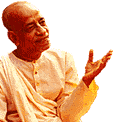Chapter 11: The Universal Form
Bg 11.51
TEXT 51
arjuna uvaca
drstvedam manusam rupam
tava saumyam janardana
idanim asmi samvrttah
sa-cetah prakrtim gatah
drstvedam manusam rupam
tava saumyam janardana
idanim asmi samvrttah
sa-cetah prakrtim gatah
SYNONYMS
arjunah uvaca—Arjuna said; drstva—seeing; idam—this; manusam—human being; rupam—form; tava—Your; saumyam—very beautiful; janardana—O chastiser of the enemies; idanim—just now; asmi—I am; samvrttah—settled; sa-cetah—in my consciousness; prakrtim—my own; gatah—I am.
TRANSLATION
When Arjuna thus saw Krsna in His original form, he said: Seeing this humanlike form, so very beautiful, my mind is now pacified, and I am restored to my original nature.
PURPORT
Here the words manusam rupam clearly indicate the Supreme Personality of Godhead to be originally two-handed. Those who deride Krsna to be an ordinary person are shown here to be ignorant of His divine nature. If Krsna is like an ordinary human being, then how is it possible for Him to show the universal form and again to show the four-handed Narayana form? So it is very clearly stated in Bhagavad-gita that one who thinks that Krsna is an ordinary person and misguides the reader by claiming that it is the impersonal Brahman within Krsna speaking, is doing the greatest injustice. Krsna has actually shown His universal form and His fourhanded Visnu form. So how can He be an ordinary human being? A pure devotee is not confused by misguiding commentaries on Bhagavad-gita because he knows what is what. The original verses of Bhagavad-gita are as clear as the sun; they do not require lamplight from foolish commentators.
Copyright (c) 1972 by His Divine Grace A.C. Bhaktivedanta Swami Prabhupada











